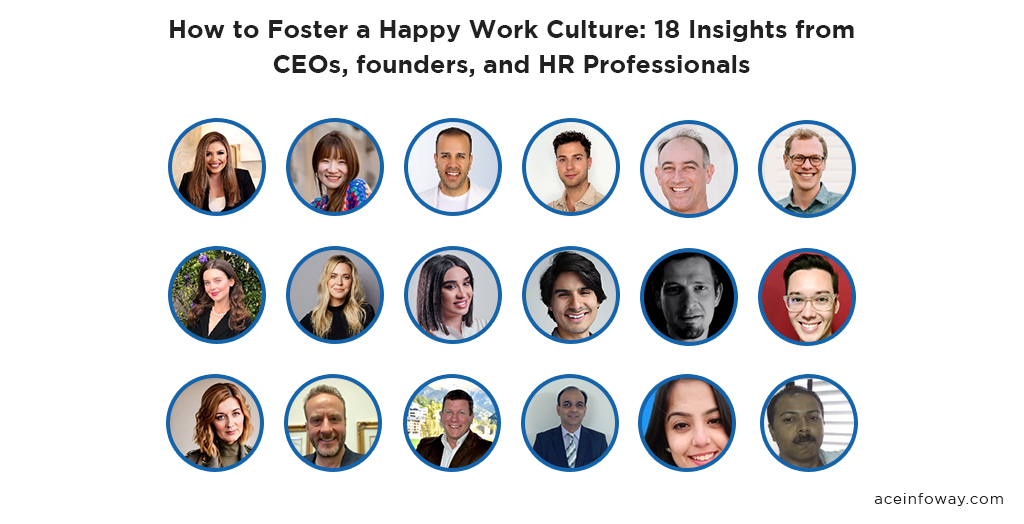Table of Contents
Creating a happy work culture is essential for employee satisfaction and productivity. We’ve gathered 17 valuable insights from CEOs, founders, and HR professionals on how they’ve successfully built a positive work environment. From embracing a work-from-anywhere culture to understanding and addressing employee needs, discover the best practices to follow in fostering a happy work culture.
- Embrace Work-From-Anywhere Culture
- Enable Flexibility for Happiness
- Promote Individuality and Freedom to Operate
- Care for Employees and Foster Fun
- Host Engaging Team-Building Events
- Hire Professionals with Culture Fit
- Focus on Goals, Not Hours Worked
- Evolve Culture and Brand Together
- Implement Daily Gratitude Stand-Ups
- Celebrate Everyday Wins Consistently
- Establish Ongoing Feedback Loops
- Offer Competitive Pay and Perks
- Link Daily Work to Company Goals
- Encourage Collaboration and Open Dialogue
- Adopt Unlimited PTO Policy
- Leadership’s Role in Company Culture
- Center Culture Around Employees and Clients
- Understand and Address Employee Needs

Embrace Work-From-Anywhere Culture
The ability to work from anywhere is the cornerstone of our happy work culture.
We’ve encouraged our employees to take full advantage of the freedom to work from anywhere, and the positive results have been incredible.
They’ve been able to spend more time with their families and friends, they’ve been able to travel, and they’ve been able to engage in activities they never thought they’d be able to.
We’ve also seen a huge uptick in productivity and employee retention. When our employees are happy, they work better, they’re more productive, and they stay with the company longer.
Matthew Ramirez, CEO, Paraphrase Tool
Enable Flexibility for Happiness
Job seekers and employees look for flexible hours and a happy work culture because it helps them manage work-life balance and improve productivity. Flexibility gives employees freedom and allows them to grow their careers the way they want to.
Here are some ways to establish a happy work culture by enabling flexibility.
Flexibility with work hours: 9-5 work is becoming an obsolete concept for employees and job seekers. They look for more flexible work hours. So, you should provide flexibility in the work hours to establish a happy work culture in the office.
Job descriptions: Your company can provide flexibility by steering clear of narrow job descriptions and fixed offices. An effective way for the same is to cross-pollinate skill sets with a shared purpose and common goals.
Remote work: Providing remote work can make employees happy. It will help you attract top talent to the company. Remote work popularity shows no sign of waning in the long future.
Saikat Ghosh, Associate Director – HR and Business, Technource
Promote Individuality and Freedom to Operate
I believe that happiness and success go hand in hand. That’s why I have a simple mantra that drives everything we do: encourage our teams to express their unique perspectives and ideas, and allow them to work with their own methods and ideas to foster a creative and innovative environment.
This approach helps us build a team of high-performing individuals who are passionate about their work and committed to achieving success.
However, to make this happen, the senior team members must provide support and resources, such as training, mentorship/direction, and access to tools and technology, that can help individuals and teams succeed.
This approach amongst many others – empowers employees to take ownership and be happy to have found their own strengths.
Vipul Shah, COO, Ace Infoway
Care for Employees and Foster Fun
Workers want their employers to care about them. That’s the basis of it, so everything you do should aspire to that one ideal. We built a happy work culture by understanding what workers need to do their jobs well and providing it, allowing for some fun in the office, and getting to know workers personally.
That means getting to know employees by name and what they do. We routinely ask if they have what they need to do their jobs. That can result in different answers as new tech emerges. We consider all requests and either tell them yes, or no, or offer an alternative. We give them a reason why no is the answer.
We allow employees to take time to talk to each other in offices or have a Friday cake day. We don’t want them to suddenly stop talking and pretend to work when we walk by, as long as they also respect our time and get their work done.
Baruch Labunski, CEO, Rank Secure
Host Engaging Team-Building Events

Building a happy work culture isn’t a quick fix – I’ve done it by hosting engaging team-building events. These events where employees play together, giggle, brainstorm, and solve problems together go a long way to cultivating a happy company culture.
For example, when our goal was to foster creativity, we had our team members work together on an art project. Also, we have even been hosting creative activities like cooking classes and art workshops lately. We got positive feedback from our employees about how these events have helped them build relationships with their colleagues and feel more connected to the company.
Conversely, if collaboration is more vital, we opt for something like a scavenger hunt where people are divided into smaller groups that must communicate with each other to succeed. And the payoff is huge – a happy work culture where employees can flourish and grow.
So, make work a fun place to be and create a thriving environment where everyone can be their best selves.
Maria Harutyunyan, Co-founder , Loopex Digital
Hire Professionals with Culture Fit
Company culture has a lot to do with the employee experience. If your employees fit in well with the company culture, they will likely have a positive employee experience because they will feel at home and like they can be themselves. This is why it is essential to hire not only skilled professionals but professionals who are good culture fits. For example, suppose your company has a very laid-back work environment. In that case, you may not want to hire those with a more corporate personality because they may feel out of place and, therefore, not completely fulfilled. Those who connect with your company’s culture will feel more satisfied in your work environment than those who do not because they will enjoy coming to work every single day.
Maegan Griffin, Founder, Ceo, Nurse Practitioner, Skin Pharm
Focus on Goals, Not Hours Worked
One of the most important aspects of creating a happy work culture is having a strong emphasis on goals and results, as opposed to focusing on hours worked. When employees feel like they can work towards meaningful goals that impact the business, they are much more likely to feel like they are part of a positive work culture. Additionally, setting expectations around hours worked can create a negative work culture where employees feel like they are being punished for not working enough hours. Instead, focus on setting realistic goals that employees can work towards, and reward them for achieving those goals, rather than punishing them for not working enough hours.
Michael Loesche, M.D., Ph.D., CEO, USMLE Test Prep
Evolve Culture and Brand Together
Scaling a brand also means scaling its culture. This is especially important for startups, as companies’ early employees have internalized the founders’ values, beliefs, attitudes, and behaviors. These same employees will have calibrated to the market primarily served when they joined the company, which may differ from the market the company is now seeking to serve. While new employees will gravitate toward pursuing the new market, a lack of cohesion between the two groups can create conflict.
To avoid this, it is vital that your culture and brand evolve so that employees see themselves in it. This means involving the entire team in the process of evolving the culture and brand. Otherwise, you may find yourself with two different teams delivering two different results.
Create a values-driven people experience program, from recruitment to onboarding and retention. Celebrate the wins and acknowledge them. No company is perfect. Always learning and growing will improve your culture and brand.
Heather Wilson, Cmp, Founder, The Brand Strategy Tank
Implement Daily Gratitude Stand-Ups
This is a practice we started during the pandemic, and has now become an integral part of our company culture and is the most important 15 minutes of every day in our office.
At 10:30, we all jump on a company Zoom meeting. The entire team joins, no matter if they are working remotely or in side-by-side offices. We call this our morning gratitude stand-up.
The meeting has the same format every morning. We go around the Zoom room, and every person states what they are grateful for today – specifically today. It can be a great night’s sleep, a call from a relative the night before, no traffic on the way to the office … it doesn’t matter. It’s whatever shined a little bit of light on their day – today.
This simple practice has brought our team so close, we feel like friends and family now. I’ve been managing teams for 25 years and have always struggled with the “how to create a good company culture” question, and this practice has been the answer.
Jeremy Shepherd, CEO, Pearl Paradise
Celebrate Everyday Wins Consistently

Celebrating the team’s everyday wins makes recognition a daily practice, motivating employees throughout the year. While we ensure satisfaction throughout the customer journey, we aim to do the same in our employee experience. Acknowledging your staff members’ successes two or three times a year doesn’t inspire them to take ownership of what they do—especially in the remote work environment. But a consistent rewards strategy that helps employees feel like they’re making daily progress in their efforts fuels their drive to perform at their best. And whether that recognition is a shoutout, gift card, or even a hand-written note, knowing what they do is appreciated helps team members understand the value they bring each day.
Daniel Kroytor, Founder and Director, Tailored Pay
Establish Ongoing Feedback Loops
An ongoing feedback loop is essential to a happy work culture. Employees should have regular opportunities to give and receive constructive feedback, as well as provide recognition for excellent performance. This looks different for each organization, but could include weekly team meetings to discuss progress and successes, quarterly individual performance reviews, and informal recognition programs such as employee of the month awards. Regular and effective feedback encourages transparency within the organization and makes it easier for employees to collaborate effectively. In fact, my team found that our feedback loops improved employee morale and creativity, which in turn enhanced our overall working environment.
Darren Shafae, Founder, ResumeBlaze
Offer Competitive Pay and Perks
While I agree that pay and perks aren’t the only things that matter when it comes to fostering a positive workplace environment, I can’t deny their importance. Providing competitive pay and perks can demonstrate to employees that they are respected and appreciated. It also aids in attracting and retaining key individuals who are vital to the company’s success.
Gerrid Smith, Chief Marketing Officer, Joy Organics
Link Daily Work to Company Goals
A good workplace and corporate culture require clarity. Teams and tools typically do silo work, making it hard to find. Without knowing what to do and why, you may feel like you’re just spinning your wheels. If you don’t already, relate daily work to company goals. Our research found that only 26% of knowledge workers understand how their work supports organizational goals. Setting goals on a slide deck or spreadsheet that gets checked quarterly doesn’t link to everyday work. Tracking company goals at work motivates and clarifies. Find goal management software that links everyday tasks to team initiatives. Thus, team members may see how they contribute to goals.
Alice Hall, Co-founder and Creative Director, Rowen Homes
Encourage Collaboration and Open Dialogue
Building a happy work culture starts with creating an environment that encourages collaboration, a celebration of successes, and an open dialogue among employees. As a manager, I ensured employees felt respected and appreciated for their hard work by providing recognition for good performance in the form of small gifts or spot bonuses. This uncommon practice not only showed my appreciation for the team’s effort but also motivated the whole group to collaborate better and enjoy coming to work each day. Additionally, I held weekly meetings where funny anecdotes could be shared amongst the team and discussed any burning issues from our past week. Doing this regularly helped release any pent-up stress or tension which in turn improved workplace happiness overall.
Amy Ling Lin, CEO, sundays studio
Adopt Unlimited PTO Policy
In my first-hand experience, one effective strategy that contributed to fostering a positive work environment was implementing an unlimited PTO (Paid Time Off) policy. This approach demonstrated trust in employees, empowering them to manage their own time and work-life balance. By giving individuals the freedom to take time off as needed, without the constraints of a traditional vacation allowance, we cultivated a sense of personal responsibility and accountability. This not only led to increased job satisfaction but also improved overall productivity.
Michael Lazar, Executive, ReadyCloud
Leadership’s Role in Company Culture

In my experience, a great company culture starts with the highest levels of leadership. These individuals are responsible for setting an example and being good role models for their employees. I am fortunate to work for a company that prioritizes family and work-life balance. Our founders openly speak to the importance of this in nearly every company meeting, and they give real examples of how they practice this daily. A great company culture is defined by how you treat your people. When you provide opportunities that fit into your employee’s interests and you give them sufficient guidance and autonomy, great things can happen! Instead of creating a toxic environment that is fueled by competition, one must strive to create a culture that inspires creativity and collaboration. This way, people are less afraid to share their ideas, as they know these thoughts are welcomed and appreciated at all levels of the organization.
Katya Hoodikoff, Sr. Recruiter, Houzz
Center Culture Around Employees and Clients
As a real estate agency, we create a work culture that centers around our employees and clients. We strive to ensure that our employees are taken care of in terms of their job security, salary, and benefits and that they feel valued and respected. On the client side, we ensure that our clients are kept informed about our services and that their needs are met. We also take time to understand their preferences to customize our services to suit their needs. This combination of strong employee relations and excellent customer service sets us apart and helps us build a positive work culture.
Peter Lucas, Owner, Relocate to Andorra
Understand and Address Employee Needs
Building a happy work culture is not just driven by the top management, but also by what the employees want and need. The culture is useless if it’s not something the employees value and appreciate. A good culture building is dynamic in nature and needs to change as the expectations of employees change over time.
To build a successful culture, you first need to understand the composition of your team members, including their seniority, years of experience, age, gender, and other factors that may influence their expectations. Then, you should prioritize transparency and equality, and ensure that your actions reflect these values.
In summary, the catalyst for defining the cultural aspects of a happy work culture must be what your people will like and value. Listening to your employees, being aware of their needs, and creating a culture that reflects those values are key to building a happy and thriving work environment.
Sanya Nagpal, Head, Human Resources, Leena AI
Conclusion
Creating a happy work culture requires a holistic approach that prioritizes the well-being of employees while still achieving the company’s objectives. It’s about finding that sweet spot where everyone is thriving, and both personal and business goals are being met. It starts with keeping your employee informed, involved, inspired, and interested.
A happy workplace cultivates employee well-being and fosters loyalty, creativity, and a sense of belonging.
Let’s work together to create a workplace culture that fosters happiness and success. We believe that when employees are happy, they’re more motivated, engaged, and committed to achieving success. To see how we’ve created a culture of Joy + Achievement at our company, check out “Life at Ace”

























